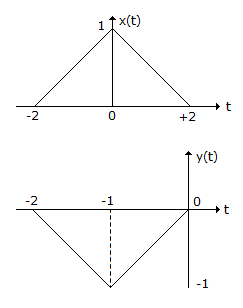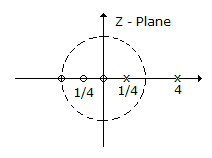Discussion
Home ‣ Electronics and Communication Engineering ‣ Signals and Systems Comments
- Question
The signal defined by the equations f(t) = 0 for t < 0, f(t) = E for 0 ? t ? a and f(t) = 0 for t > a is
Options- A. a step function
- B. a pulse function
- C. a shifted step function originating at t = a
- D. none of the above
- Correct Answer
- a pulse function
ExplanationIt is a pulse lasting for t = a.
Signals and Systems problems
Search Results
- 1. If I (s)
 , the final value of i(t) is
, the final value of i(t) is
Options- A. 5A
- B. 12.5 A
- C. 0.05 A
- D. 1250 A Discuss
Correct Answer: 12.5 A
Explanation:

- 2. Two function g1(t) and g2(t) with correlation of 6 has average power of 4 and 5 respectively. The power of g1(t) + g2(t) is
Options- A. 9
- B. 21
- C. 3
- D. 15 Discuss
Correct Answer: 21
Explanation:
Power of two correlated signal is P = P1 + P2 +2R1, 2(t).- 3. A function having frequency f is to be sampled. The sampling time T should be
Options- A.

- B.

- C.

- D.
 Discuss
Discuss
Correct Answer:
Explanation:
Sampling frequency must be more than 2f. Therefore .
.
- 4. The present total cost per watt of power generation in geosynchronous orbit is nearly Rs.
Options- A. 20
- B. 50
- C. 100
- D. 5 Discuss
Correct Answer: 20
- 5. Radio broadcasting is a familiar example of
Options- A. space multiplexing
- B. time multiplexing
- C. frequency multiplexing
- D. none of the above Discuss
Correct Answer: frequency multiplexing
- 6. Let x(t) and y(t) with F.T. x(f) and y(f) respectively be related as shown in figure

Then y(f) is
Options- A.

- B.

- C. -X(f/2)ej2pf
- D. -X(f/2)e- j2pf Discuss
Correct Answer:
Explanation:
By applying time shifting and scaling property.- 7. A voltage wave having 5% fifth harmonic content is applied to a series RC circuit. The percentage fifth harmonic content in the current wave will be
Options- A. 5%
- B. more than 5%
- C. less than 5%
- D. equal or more than 5% Discuss
Correct Answer: more than 5%
Explanation:
IC = V(j?C).- 8. The system with given pole-zero diagram is

Options- A. casual
- B. non-casual
- C. both sided
- D. not-possible Discuss
Correct Answer: not-possible
Explanation:
Because no.of zero is more than Pole, therefore when you find transfer function.Numerator power will higher than denominator, and such transfer functions is not realizable.
- 9. If £[f(t)] = F(s), then £[f(t - T)] =
Options- A. est F(s)
- B. e-st F(s)
- C.

- D.
 Discuss
Discuss
Correct Answer: e-st F(s)
Explanation:
A linear system is one in which the relationship between input and output is linear.All linear system possess the property of superposition i.e., if input u1 gives output y1 and input u2 gives output y2 then input u1 + u2 will give output y1 + y2.
Superposition implies homogencity i.e., if input u gives output y, then input ku gives output ky where k is a rational number.
In general a system is linear if a transformation T satisfies the relation
T(au1 + ?u2) = aT(u1) + ?T(u2)
where a and ? are constant.
- 10. As per time displacement theorem in Laplace transformation, displacement in the time domain by T becomes
Options- A. division by s in the s domain
- B. division by e-sT in the s domain
- C. multiplication by s in the s domain
- D. multiplication by e-sT in the s domain Discuss
Correct Answer: multiplication by e-sT in the s domain
Explanation:
£f(t - T) = e-st F(s).
Comments
There are no comments.
More in Electronics and Communication Engineering:
Programming
Copyright ©CuriousTab. All rights reserved.
- 1. If I (s)
